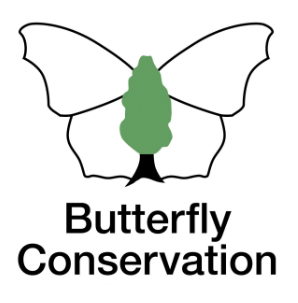Brown Argus
Brown Hairstreak
Chalkhill Blue
Clouded Yellow
Comma
Common Blue
Dark Green Fritillary
Dingy Skipper
Essex Skipper
Gatekeeper
Green Hairstreak
Green-veined White
Grizzled Skipper
Holly Blue
Large Skipper
Large White
Marbled White
Meadow Brown
Orange-tip
Painted Lady
Peacock
Purple Emperor
Purple Hairstreak
Red Admiral
Ringlet
Silver-washed Fritillary
Small Blue
Small Copper
Small Heath
Small Skipper
Small Tortoiseshell
Small White
Speckled Wood
Wall
White Admiral
White-letter Hairstreak
Extinct/rare immigrants
Purple Hairstreak
Favonius quercus
General Distribution and Status
The Purple Hairstreak is our commonest hairstreak, more abundant in southern Britain than further north where it is increasingly local. Although it is still periodically abundant in places it is likely that many colonies were lost in the 20th century due to the clearance of oak woods and in some cases replaced by conifer plantations. It appears in fewer localities than in 1976 and the abundance on monitored sites has also been reduced since the 1970s (Brereton et al., Fox et al.). In Hertfordshire and Middlesex, similar declines occurred in the 20th century although numbers hit new peaks in the mid 1990s since when numbers have fallen once again (Wood, 2016) but 2018 was an exceptional year with many records of the butterfly seen at low levels (Wood, 2019). However, it is difficult to gauge long-term trends for this butterfly through its elusiveness and habit of frequenting the tree tops coupled with the fact that many specimens are now seen at low levels to feed away from the tree-tops owing to a lack of honeydew in the recent drier conditions in the summer.
| United Kingdom | Herts & Middx | |||
| Distribution | 1976-2019 | -57% | 1980-2015 | +57% |
| Average 10-year trend | -18% | 2006-2015 | -17% | |
| 2024 since 2015-19 | -8% | |||
| Abundance | 1976-2024 | -21% | 1980-2015 | -69% |
| 2015-2024 | +4% | 2006-2015 | +98% | |
| 2023-2024 | -45% | 2024 since 2015-19 | -14% | |
UK distribution map
UKBMS Species summary
Habitat Requirements
The species is found mostly in oak woodlands. Small colonies may sometimes be supported on isolated oak trees.
Larval Foodplants
Pedunculate Oak Quercus robur, Sessile Oak Q. petraea.
Adult Food Sources
Honeydew (21), Bramble Rubus fruticosus agg. (7), Hemp Agrimony Eupatorium cannabinum (6), ground/mud/road surface (4).
Historical Records
Gibbs refers to the butterfly as the 'most abundant of the Hertfordshire hairstreaks' and mentions Matthews' sightings at Norton Green Woods in around 1900. Although Foster describes it as an 'undoubtedly scarce insect' it was almost certainly under-recorded. Roger Ferry on his visits to Knebworth Woods in the 1940s and 1950s found it common. On 11 August 1946 it was abundant in Newton Wood on aspen and a week later he captured 7 individuals from the area. In 1953, he found 4 specimens on the head of a hogweed. It was probably common in most of the county throughout the 20th century but Waterton in his 1970-81 report states that it was 'apparently confined to the south-east of the county ... '.
Local Distribution and Abundance
The Purple Hairstreak occurs mostly in the wooded areas around Stevenage and is most abundant in the Knebworth Woods complex where the large majority of sightings are recorded. The highest count was recorded there on 24 July 2004 and on 12 July 2018 when an estimated 100 were seen which accounts for a slightly uneven distribution of abundance on the phenology chart. It is under-recorded and it is possible that every mature oak tree in our area will support colonies. In the current 5-year cycle (2020-2024) first-ever known records came from the far west (TL22C and TL22D) which is predominantly agricultural land. 2018 was an exceptional year at the Knebworth Woods complex - see below for transect results. 2024 was the worst year since 2012, with only seven reports, one of which recorded five specimens during a Wider Countryside Butterfly Survey in the Knebworth Woods complex on 27 June.

Stevenage (South Fairlands Valley Park) transect 1993-2025
The first Purple Hairstreak I saw here was in 2005 but because of its tree-topping behaviour I did not look for it before then. I find most individuals on a tall oak tree by the dew pond in Monks Wood but undoubtedly there are other populations in both Monks Wood and Whomerley Wood. In 2016 I discovered a colony in Whomerley Wood on the edge of the recently cleared area on the northern side. Another good spot is north of the Stevenage Scouts Activity Centre where there are tall oaks lining the track. I have not included an abundance chart due to a lack of consistent recording effort since the start of the survey.Knebworth Park transect 1996-2010 and 2017-2025
During the 1996-2010 survey only four specimens were recorded; three in 1996 and one in 1998. In 2017, one was seen on the ground in a field north of Graffidge Wood on 13 August. The one individual I found in 2022 was on the gravelly track at Burleigh Farm on 30 July. One was seen over a hedge between Graffidge Wood and Rusling End on 17 July 2024.Knebworth Woods transect 2017-2025
2018 was the best on record in this area in my experience and numbers reflect how many were seen at low levels. Perhaps the dry conditions in mid summer facilitated a reduction of edible honeydew, secreted by aphids, on the oak leaves so prompting the butterfly to seek alternative food sources. A number were seen low down in 2020 too although generally abundance was low. Only five were seen since 2020.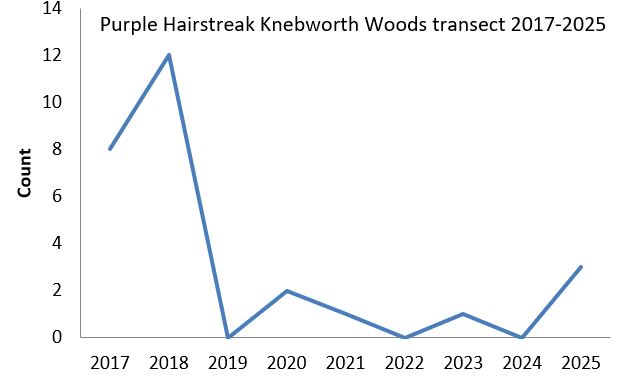
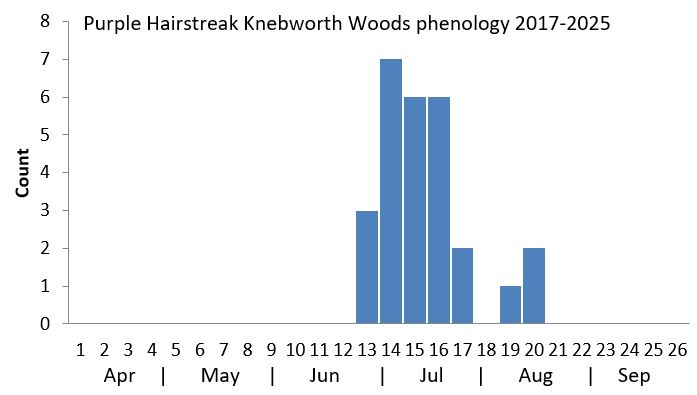
Pryor's Wood transect 2000-2022
In 2008, two were seen on 11 August and in 2009, one on 8 August.Life History
Earliest date: 23 June 2017 at Norton Green Common
Latest date: 8 September 2012 at Watery Grove
The Purple Hairstreak is on the wing
in July and August with a few lingering on into September. Only one brood is produced each year. Eggs are laid singly on oak twigs or buds and overwinter in this stage. Females are not as selective on aspect or height of the oak
trees on where to lay the eggs (Heath et al.). Larvae, which emerge in April, feed in the oak buds then the leaves.
Pupae are formed in a cocoon usually on the ground.
More details on the UK Butterflies website
Behaviour/Observation notes
The best time to see the Purple Hairstreak is on a calm warm evening in July on tops of tall oak trees when they are most active, especially the males which defend their territories over the canopy. The butterfly does come down to lower levels on brambles, for example, especially after a spell of rain which may have washed away the honeydew on the oak leaves. Wings are usually closed when feeding but they open occasionally to provide good views of their uppersides.
Variations/Aberrations
Variations or aberrations are very rare or unknown for the Purple Hairstreak.
Find out more on the UK Butterflies website
References
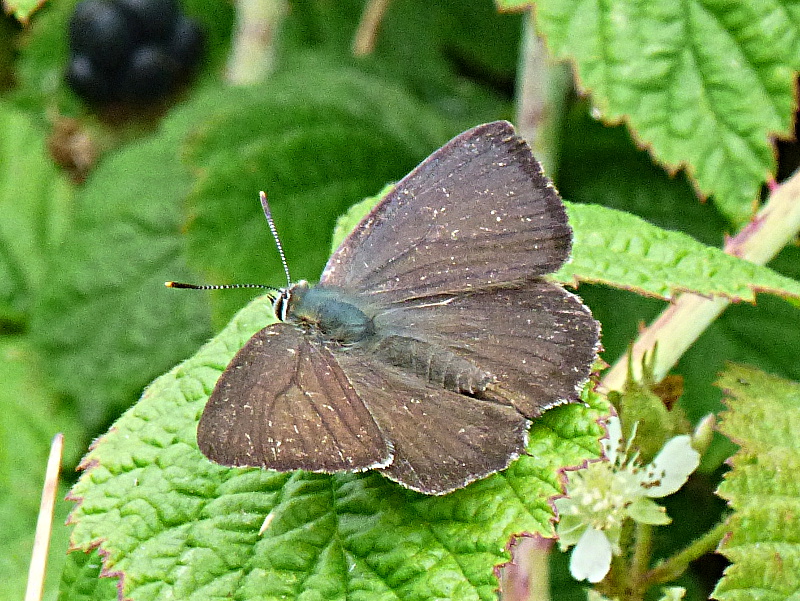
Norton Green Common 20 Jul 2018 (m)
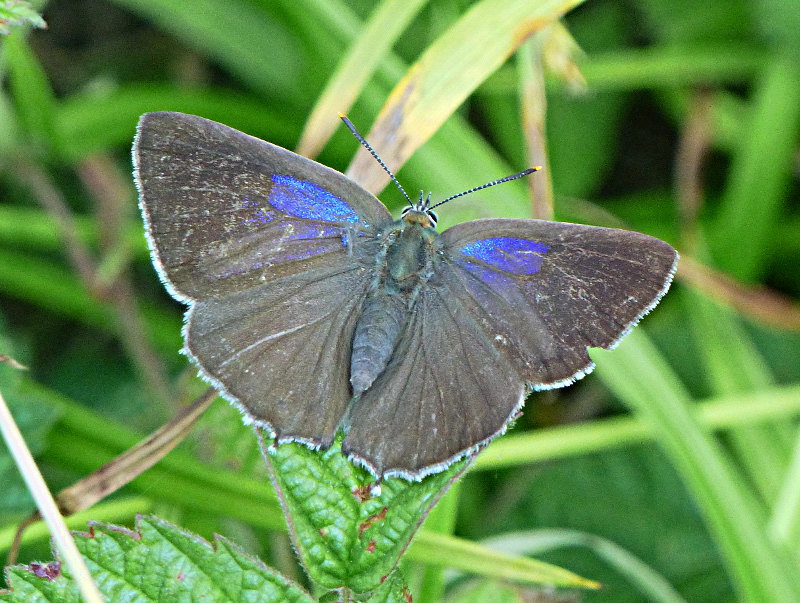
Norton Green Common 11 Jul 2018 (f)
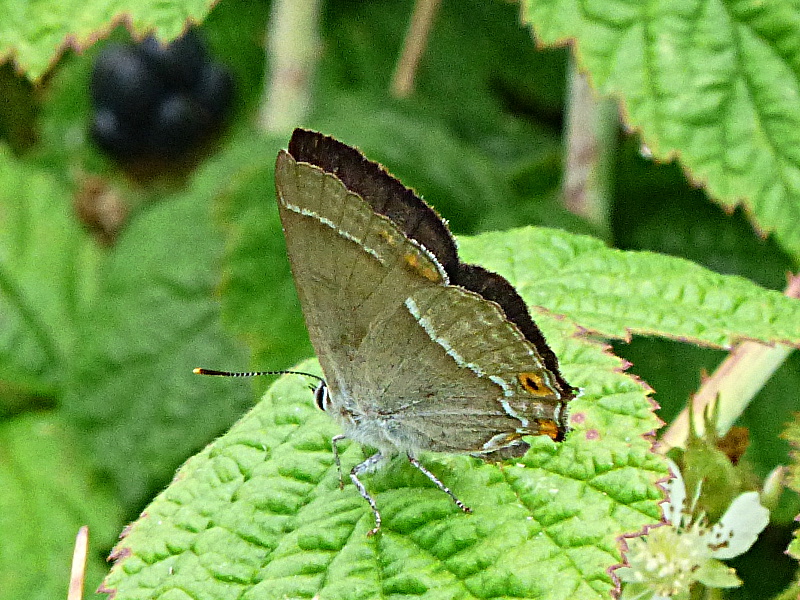
Norton Green Common 20 Jul 2018
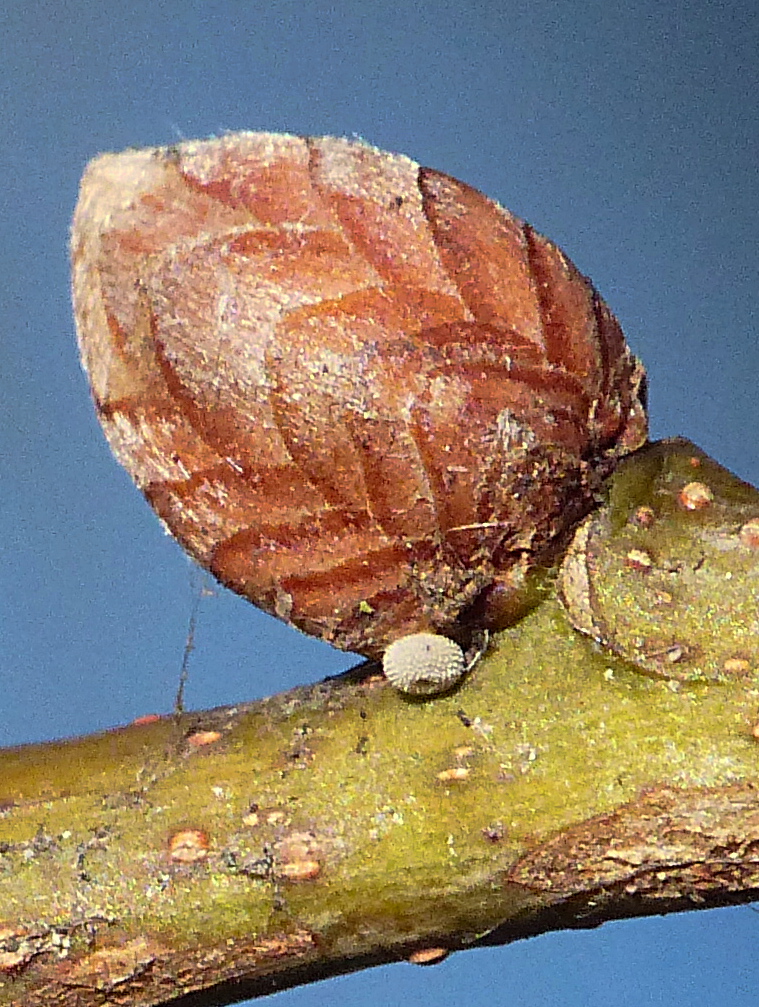
Egg Watery Grove 22 Dec 2018
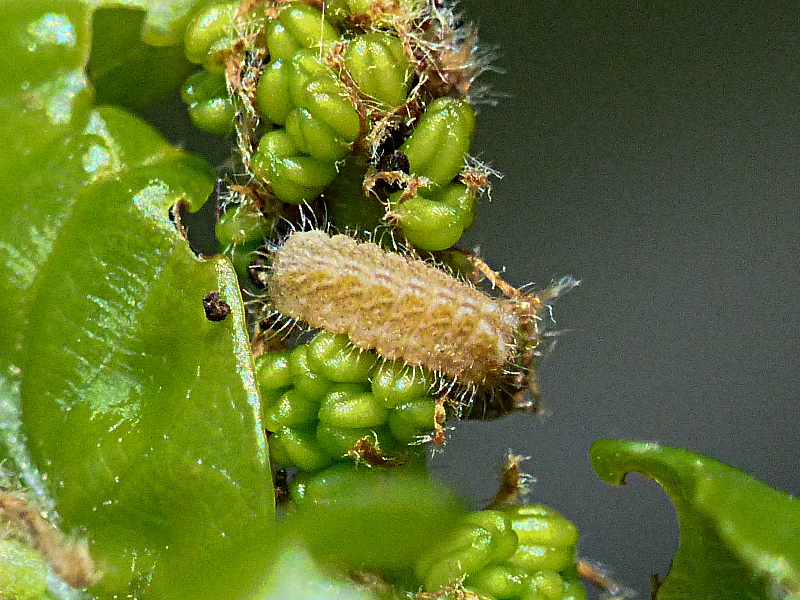
Larva Watery Grove 21 Apr 2019
